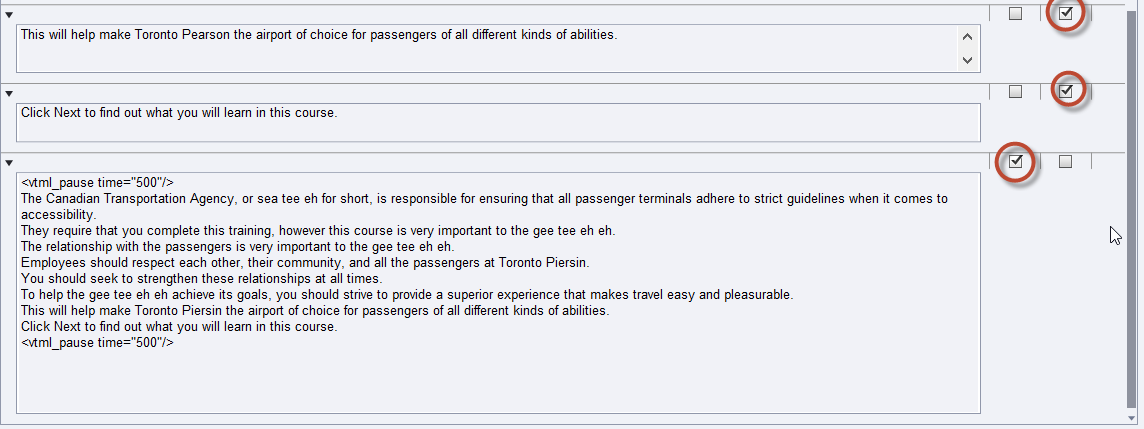 Adobe Community
Adobe Community
- Home
- Captivate
- Discussions
- The VTML goes into the Text to Speech dialog. Basi...
- The VTML goes into the Text to Speech dialog. Basi...
VTML markup in user dictionary - voicetext text-to-speech
Copy link to clipboard
Copied
Hello,
I am working with Captivate 10 and the "integrated" voicetext text-to-speech. I have used the voicetext user dictionary already to improve/change pronounciation of words.
I have some words where I would like to speed up the TTS and I would like to do this for every occurence of these words in the TTS. Obviously I could extend the TTS texts accordingly with the respective markup, e.g. <vtml_speed value=150>myword</vtml_speed>, but I prefer to have the correct text in the TTS Management, e.g. for possible translations without disturbance (i.e. the vtml markup). Addtionally it would be much easier to write the TTS if the vtml-"tagging" that has to be done repeatedly could be done "centrally".
A possible solution could have been to add these words to the user dictionary but unfortunately the VTEditor resp. the UserDictionary does not accept texts as a target that include the vtml markup. (certainly 😉 I have tried to manipulate the userdict_eng.csv of the voice I use directy but the voicetext engine simply ignores these entries).
Does anyone have an suggestion/workaround to solve this issue? As said my idea is to keep the correct "vtml-free" (at least as much as possible) texts in the TTS and would like manipulate and manage the pronounciation/speed/pauses in the user dictionary centrally. (and I do not want to write separate texts in the slide comments, i.e. one comment with correct texts and one comment for the TTS including the vtml-markup).
Thanks in advance for your help!
Copy link to clipboard
Copied
What I do is maintain separate closed captioning and text to speech notes in my notes panel.

It's a bit more work but it allows me to add VTML to my text to speech but still have a clean set of notes for my closed captioning.
Copy link to clipboard
Copied
Thanks for your answer Paul! I understand your approach.
In your texts I recognize that you put things like "gee tee eh eh" instead of (I guess) GTAA. What is the reason for this?
Via the Neospeech user dictionary you could "correct" the pronounciation of these abbreviations in a central place and still write the correct text/abbreviaition in your captions and TTS. The TTS engine will automatically replace the abbreviation with your pronounciation from the user dictionary and you have cleaner texts in the annotations and less to type/remember. There is a youtube video that describes the approach and where to find the voicetext editor (search for "Adobe Captivate Text to Speech Hints and Tips").
In the example above the following user dictionary entry should do the trick --> source "GTAA" - target "G T A A". If you work with a team you could share the userdict_eng.csv of the voice you are using with your colleagues.
As said above I already use the user dictionary but my concrete problem (and idea) was as follows:
I would like to improve the pronounciation of the word "ATM". It is basically ok if you create the audio from TTS but it sounds a bit like "A T M" (i.e. with pauses), So, to have it faster/more fluent, my idea was to speed up via "<vtml_speed value=150>ATM</vtml_speed>". Certainly this works... My idea was now "Ok - it works, but it is a bit annoying to write all the time "<vtml_speed value=150>ATM</vtml_speed>" instead of "ATM" (I know there are tools out that could also autmatically replace the strings in the TTS annotation when I am typing, but I simply want to keep out the vtml markup as whereever possible from my annotations).
As said in my previous post, my idea was to add this to the user dictionary (source:"ATM" - target: "<vtml_speed value=150>ATM</vtml_speed>") but VTEditor rejects texts as "invalid target" as soon as vtml markup is included.
If I think this approach further it would also be an option to create user dictionary entries for text snippets, e.g. if you have a longer text like "How to use this WBT [several sentences following]" you could use a shortcut like "HTUTW" and if this could be replaced via the user dictionary you only have to type the abbreviation into the slide annotation (TTS) which would be replaced by the complete text during generation of the audio...anyway, I am afraid there is no solution to my requirement (at least w/o extending the voicetext TTS engine).
Best regards!
Copy link to clipboard
Copied
Yes, not only am I aware of this video that you speak of; I'm the person who recorded it.
You should know that the license you get for the Neospeech VoiceText is not a full license. Adobe installs parts of the VoiceText tool to make the speech agents work with Captivate, but there is much missing from the installation. In my video, I show you how you can use the VTEditor software to massage your narration and use the inbuilt features to inject the VTML, but it isn't meant to be used this way.
I've been working with the text to speech component for about seven years now, and I can tell you that eventually, you have to compromise your notes to get it to speak correctly. There is a creek near where I worked called Etobicoke, which is pronounced ee toe bee co. It's not a common word, and the K is silent. I have never been able to get the Neospeech user dictionary to work as you would expect it. In the end, I've ended up with the solution of entering two separate sets of notes, one for the text to speech and one for the closed captioning (and translations when I've needed it).
The GTAA issue is that the speech agent software recognises the GTAA as an acronym like NASA or NATO, when in fact it is a set of initials that are stylized as an acronym. Usually, you would write G.T.A.A. using the periods but their brand, their rules. I got in the habit of writing out items such as this phonetically. It seemed to give me better results and acted as a clear reminder that on the set of notes for closed captioning, I needed to update this to how it should appear to the end users.
Copy link to clipboard
Copied
Indeed! Sorry Paul, I did not recognize...(obviously).
Thanks a lot for your explanations and the video that is a really good start for TTS customizing in Captivate!
Best regards!
Carsten
Copy link to clipboard
Copied
Where does the VTML go? I tried inserting it into the slide notes, but it doesn't work there for me.
Copy link to clipboard
Copied
